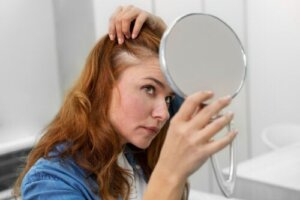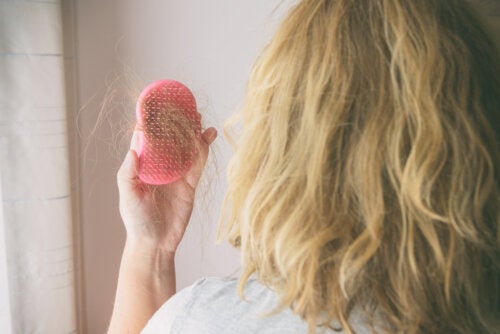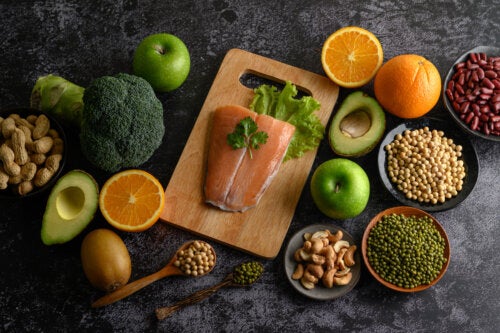5 Foods to Prevent Postpartum Hair Loss

For women, hair has high value as a sign of good health. Its beautification during pregnancy can turn into real anguish when it starts to fall out after childbirth. Among the solutions, the nutritional ones are the easiest to find. Therefore, in this article, you’ll learn about foods that help prevent postpartum hair loss.
While it’s true that hair loss after childbirth is temporary, it can last from 3 to 4 months. So, to prevent it, you can consume certain nutrients that maintain the hair growth cycle, from pregnancy or before it.
Do you want to prevent postpartum hair loss? Then keep reading.

Postpartum hair loss: Can nutrition help prevent it?
Postpartum hair loss is also called “postpartum telogen effluvium”. It’s a condition that affects 40-50% of women after giving birth during the first few months.
During pregnancy, progesterone keeps hair shiny, but after birth its concentration decreases and this causes abrupt hair loss.
In addition to the hormonal factor, nutrition plays an important role in hair health. A paper in the journal Dermatologic Clinic describes this. It’s especially true during the hair growth phase when essential elements such as proteins, vitamins, and minerals are required to produce healthy hair efficiently.
When there’s a deficiency of any of these nutrients, structural abnormalities, pigmentation changes, and dreaded hair loss can occur.
Proteins, iron, zinc, biotin, vitamins A, C, D, and E, and omega-3 are the essential nutrients involved in strengthening hair. The review published in Dermatology and Therapy in 2019, clearly explains the effect of these nutrients to control and prevent postpartum hair loss.
So, let’s explore the foods that contain the key nutrients to prevent postpartum hair loss and improve hair health.
5 foods to prevent postpartum hair loss
Here are the food groups that stand out for their content of nutrients that support the natural hair growth cycle. Fortunately, the same food can have several of them. Let’s review.
1. Animal protein and legumes
This food group is made up of lean meats, eggs, fish, and skimmed dairy products. Legumes include peas, lentils, beans, and chickpeas, among others. These are a source of high-quality proteins.
According to the article cited in the journal Dermatology Practical & Conceptual the structure and growth of hair can be affected by low protein and calorie intake. Especially since the hair follicle is made of protein and needs it.
In addition, these foods contain other nutrients that support hair health. For example, eggs provide biotin, a vitamin that is used to produce the hair protein known as keratin.
A review in the journal Skin Appendage Disorders explains that biotin supplementation improves hair loss symptoms.
On the other hand, the protein food group also has iron and zinc, two key nutrients that also prevent hair loss. In foods of animal origin, these minerals are easily absorbed.
An article published in ACS Omega in 2022 states that animal iron is absorbed between 25 to 30%, while those of plant origin are absorbed between 7 to 9%.
2. Spinach and other leafy greens
Spinach and other leafy greens, such as Swiss chard, contain iron and vitamin A that benefit hair growth. According to the United States Department of Agriculture (USDA) nutritional table, one cup of spinach provides 13% of a mother’s postpartum vitamin A needs.
Iron contains 3 milligrams per 100 grams of leaves, according to the same nutritional table. In spite of being a low-absorption iron, it can add to the mother’s daily intake, especially due to the amount of blood lost during childbirth.
In addition, a study published in the journal Skin Appendage Disorders in 2022 notes that women with hair loss may benefit from dietary iron intake by increasing values of ferritin, an iron transporter in the blood.
3. Nuts and seeds
Nuts and seeds such as chia, flaxseed, and sunflower seeds, among others, are important sources of zinc, B vitamins, and alpha-linolenic fatty acid, a precursor to omega-3 fatty acids (EPA and DHA), which are linked to hair strengthening.
A group of researchers published in the journal Annals of Dermatology that any alteration in zinc metabolism directly affects hair loss.
At the same time, the Journal of Cosmetic Dermatology suggests in this article that omega-3 and omega-6 supplementation in women prevents hair loss, improving hair density and decreasing the rate of telogen effluvium.
The nut and seed group also brings vitamin E to the body, a potent antioxidant that keeps the hair follicle strong. This vitamin is also found in oils such as extra virgin olive oil.
A handful of nuts a day (40 grams) or seeds, preferably roasted, will be sufficient.
4. Fatty fish
Fatty fish such as salmon, sardines, anchovies, mackerel, and tuna, among others, are distinguished for being the main source of the omega-3s DHA and EPA. As mentioned in the previous paragraph, these fatty acids promote hair growth.
In addition, as indicated in the USDA nutrient table, oily fish also contain vitamin D, which, as mentioned above, is associated with hair health.
For example, a study published in the International Journal of Trichology explains the direct relationship between low vitamin D levels and hair loss in young women. In addition, the journal Advances in Dermatology and Allergology points out the importance of supplementing with vitamin D as part of the treatment of hair loss.

5. Fruits and vegetables
Fruits and vegetables such as strawberries, peppers, kiwi, guava, and citrus fruits (orange, grapefruit, lemon), among others, are a source of 2 powerful antioxidants such as vitamin C and vitamin A.
Both nutrients play an important role in hair health and protection against oxidative stress, which is related to follicle damage and hair loss, as suggested by a team of specialists in the journal The Journal of Investigative Dermatology.
An article in the International Journal of Cosmetic Science also highlights the relationship of vitamin C with the production of collagen – a key protein in hair production – especially because it also acts as an antioxidant.
To increase the intake of vitamin A in the diet, you should also include sweet potato, carrots, mango, broccoli, pumpkin, and papaya, among other yellow or orange vegetables.
How should the diet to prevent postpartum hair loss be?
You already know that postpartum hair loss is something natural and transitory. It only lasts a few months, but if you want more peace of mind and to keep your hair shiny and abundant, transform your eating style to a healthy one, even before pregnancy.
You should include protein foods such as fish, poultry, eggs, legumes, and low-fat dairy products. Fresh fruits and vegetables will increase your vitamin A and C levels. Leafy greens, nuts, fatty fish, olive oil, and oilseeds will provide omega-3, iron, vitamin D, and vitamin E.
A balanced and varied combination of each food group will ensure the natural intake of nutrients that promote hair growth. The use of supplements and treatment in general will be in the hands of the medical specialist.
For women, hair has high value as a sign of good health. Its beautification during pregnancy can turn into real anguish when it starts to fall out after childbirth. Among the solutions, the nutritional ones are the easiest to find. Therefore, in this article, you’ll learn about foods that help prevent postpartum hair loss.
While it’s true that hair loss after childbirth is temporary, it can last from 3 to 4 months. So, to prevent it, you can consume certain nutrients that maintain the hair growth cycle, from pregnancy or before it.
Do you want to prevent postpartum hair loss? Then keep reading.

Postpartum hair loss: Can nutrition help prevent it?
Postpartum hair loss is also called “postpartum telogen effluvium”. It’s a condition that affects 40-50% of women after giving birth during the first few months.
During pregnancy, progesterone keeps hair shiny, but after birth its concentration decreases and this causes abrupt hair loss.
In addition to the hormonal factor, nutrition plays an important role in hair health. A paper in the journal Dermatologic Clinic describes this. It’s especially true during the hair growth phase when essential elements such as proteins, vitamins, and minerals are required to produce healthy hair efficiently.
When there’s a deficiency of any of these nutrients, structural abnormalities, pigmentation changes, and dreaded hair loss can occur.
Proteins, iron, zinc, biotin, vitamins A, C, D, and E, and omega-3 are the essential nutrients involved in strengthening hair. The review published in Dermatology and Therapy in 2019, clearly explains the effect of these nutrients to control and prevent postpartum hair loss.
So, let’s explore the foods that contain the key nutrients to prevent postpartum hair loss and improve hair health.
5 foods to prevent postpartum hair loss
Here are the food groups that stand out for their content of nutrients that support the natural hair growth cycle. Fortunately, the same food can have several of them. Let’s review.
1. Animal protein and legumes
This food group is made up of lean meats, eggs, fish, and skimmed dairy products. Legumes include peas, lentils, beans, and chickpeas, among others. These are a source of high-quality proteins.
According to the article cited in the journal Dermatology Practical & Conceptual the structure and growth of hair can be affected by low protein and calorie intake. Especially since the hair follicle is made of protein and needs it.
In addition, these foods contain other nutrients that support hair health. For example, eggs provide biotin, a vitamin that is used to produce the hair protein known as keratin.
A review in the journal Skin Appendage Disorders explains that biotin supplementation improves hair loss symptoms.
On the other hand, the protein food group also has iron and zinc, two key nutrients that also prevent hair loss. In foods of animal origin, these minerals are easily absorbed.
An article published in ACS Omega in 2022 states that animal iron is absorbed between 25 to 30%, while those of plant origin are absorbed between 7 to 9%.
2. Spinach and other leafy greens
Spinach and other leafy greens, such as Swiss chard, contain iron and vitamin A that benefit hair growth. According to the United States Department of Agriculture (USDA) nutritional table, one cup of spinach provides 13% of a mother’s postpartum vitamin A needs.
Iron contains 3 milligrams per 100 grams of leaves, according to the same nutritional table. In spite of being a low-absorption iron, it can add to the mother’s daily intake, especially due to the amount of blood lost during childbirth.
In addition, a study published in the journal Skin Appendage Disorders in 2022 notes that women with hair loss may benefit from dietary iron intake by increasing values of ferritin, an iron transporter in the blood.
3. Nuts and seeds
Nuts and seeds such as chia, flaxseed, and sunflower seeds, among others, are important sources of zinc, B vitamins, and alpha-linolenic fatty acid, a precursor to omega-3 fatty acids (EPA and DHA), which are linked to hair strengthening.
A group of researchers published in the journal Annals of Dermatology that any alteration in zinc metabolism directly affects hair loss.
At the same time, the Journal of Cosmetic Dermatology suggests in this article that omega-3 and omega-6 supplementation in women prevents hair loss, improving hair density and decreasing the rate of telogen effluvium.
The nut and seed group also brings vitamin E to the body, a potent antioxidant that keeps the hair follicle strong. This vitamin is also found in oils such as extra virgin olive oil.
A handful of nuts a day (40 grams) or seeds, preferably roasted, will be sufficient.
4. Fatty fish
Fatty fish such as salmon, sardines, anchovies, mackerel, and tuna, among others, are distinguished for being the main source of the omega-3s DHA and EPA. As mentioned in the previous paragraph, these fatty acids promote hair growth.
In addition, as indicated in the USDA nutrient table, oily fish also contain vitamin D, which, as mentioned above, is associated with hair health.
For example, a study published in the International Journal of Trichology explains the direct relationship between low vitamin D levels and hair loss in young women. In addition, the journal Advances in Dermatology and Allergology points out the importance of supplementing with vitamin D as part of the treatment of hair loss.

5. Fruits and vegetables
Fruits and vegetables such as strawberries, peppers, kiwi, guava, and citrus fruits (orange, grapefruit, lemon), among others, are a source of 2 powerful antioxidants such as vitamin C and vitamin A.
Both nutrients play an important role in hair health and protection against oxidative stress, which is related to follicle damage and hair loss, as suggested by a team of specialists in the journal The Journal of Investigative Dermatology.
An article in the International Journal of Cosmetic Science also highlights the relationship of vitamin C with the production of collagen – a key protein in hair production – especially because it also acts as an antioxidant.
To increase the intake of vitamin A in the diet, you should also include sweet potato, carrots, mango, broccoli, pumpkin, and papaya, among other yellow or orange vegetables.
How should the diet to prevent postpartum hair loss be?
You already know that postpartum hair loss is something natural and transitory. It only lasts a few months, but if you want more peace of mind and to keep your hair shiny and abundant, transform your eating style to a healthy one, even before pregnancy.
You should include protein foods such as fish, poultry, eggs, legumes, and low-fat dairy products. Fresh fruits and vegetables will increase your vitamin A and C levels. Leafy greens, nuts, fatty fish, olive oil, and oilseeds will provide omega-3, iron, vitamin D, and vitamin E.
A balanced and varied combination of each food group will ensure the natural intake of nutrients that promote hair growth. The use of supplements and treatment in general will be in the hands of the medical specialist.
All cited sources were thoroughly reviewed by our team to ensure their quality, reliability, currency, and validity. The bibliography of this article was considered reliable and of academic or scientific accuracy.
- Almohanna, H. M., Ahmed, A. A., Tsatalis, J. P., & Tosti, A. (2019). The Role of Vitamins and Minerals in Hair Loss: A Review. Dermatology and therapy, 9(1), 51–70. https://doi.org/10.1007/s13555-018-0278-6
- Finner A. M. (2013). Nutrition and hair: deficiencies and supplements. Dermatologic clinics, 31(1), 167–172. https://doi.org/10.1016/j.det.2012.08.015
- Guo, E. L., & Katta, R. (2017). Diet and hair loss: effects of nutrient deficiency and supplement use. Dermatology practical & conceptual, 7(1), 1–10. https://doi.org/10.5826/dpc.0701a01
- Kil, M. S., Kim, C. W., & Kim, S. S. (2013). Analysis of serum zinc and copper concentrations in hair loss. Annals of dermatology, 25(4), 405–409. https://doi.org/10.5021/ad.2013.25.4.405
- Le Floc’h, C., Cheniti, A., Connétable, S., Piccardi, N., Vincenzi, C., & Tosti, A. (2015). Effect of a nutritional supplement on hair loss in women. Journal of cosmetic dermatology, 14(1), 76–82. https://doi.org/10.1111/jocd.12127
- Nayak, K., Garg, A., Mithra, P., & Manjrekar, P. (2016). Serum Vitamin D3 Levels and Diffuse Hair Fall among the Student Population in South India: A Case-Control Study. International journal of trichology, 8(4), 160–164. https://doi.org/10.4103/ijt.ijt_57_16
- Patel, D. P., Swink, S. M., & Castelo-Soccio, L. (2017). A Review of the Use of Biotin for Hair Loss. Skin appendage disorders, 3(3), 166–169. https://doi.org/10.1159/000462981
- Piskin, E., Cianciosi, D., Gulec, S., Tomas, M., & Capanoglu, E. (2022). Iron Absorption: Factors, Limitations, and Improvement Methods. ACS omega, 7(24), 20441–20456. https://doi.org/10.1021/acsomega.2c01833
- Tamer, F., Yuksel, M. E., & Karabag, Y. (2020). Serum ferritin and vitamin D levels should be evaluated in patients with diffuse hair loss prior to treatment. Postepy dermatologii i alergologii, 37(3), 407–411. https://doi.org/10.5114/ada.2020.96251
- Treister-Goltzman, Y., Yarza, S., & Peleg, R. (2022). Iron Deficiency and Nonscarring Alopecia in Women: Systematic Review and Meta-Analysis. Skin appendage disorders, 8(2), 83–92. https://doi.org/10.1159/000519952
- Trüeb R. M. (2015). The impact of oxidative stress on hair. International journal of cosmetic science, 37 Suppl 2, 25–30. https://doi.org/10.1111/ics.12286
- U.S. Department of Agriculture (USDA). Fish, salmon, Atlantic, farmed, raw. Disponible en: https://fdc.nal.usda.gov/fdc-app.html#/food-details/175167/nutrients
- Upton, J. H., Hannen, R. F., Bahta, A. W., Farjo, N., Farjo, B., & Philpott, M. P. (2015). Oxidative stress-associated senescence in dermal papilla cells of men with androgenetic alopecia. The Journal of investigative dermatology, 135(5), 1244–1252. https://doi.org/10.1038/jid.2015.28
This text is provided for informational purposes only and does not replace consultation with a professional. If in doubt, consult your specialist.








